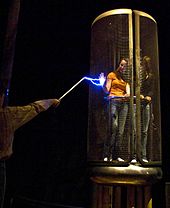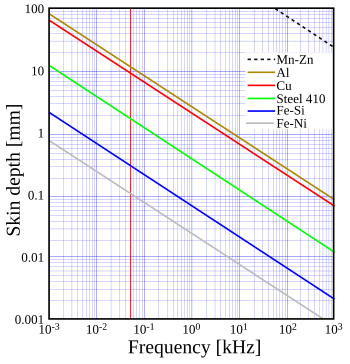



A Faraday cage or Faraday shield is an enclosure used to block electromagnetic fields. A Faraday shield may be formed by a continuous covering of conductive material, or in the case of a Faraday cage, by a mesh of such materials. Faraday cages are named after scientist Michael Faraday, who first constructed one in 1836.
A Faraday cage operates because an external electrical field causes the electric charges within the cage's conducting material to be distributed so that they cancel the field's effect in the cage's interior. This phenomenon is used to protect sensitive electronic equipment (for example RF receivers) from external radio frequency interference (RFI) often during testing or alignment of the device. They are also used to protect people and equipment against electric currents such as lightning strikes and electrostatic discharges, since the enclosing cage conducts current around the outside of the enclosed space and none passes through the interior.
Faraday cages cannot block stable or slowly varying magnetic fields, such as the Earth's magnetic field (a compass will still work inside one). To a large degree, however, they shield the interior from external electromagnetic radiation if the conductor is thick enough and any holes are significantly smaller than the wavelength of the radiation. For example, certain computer forensic test procedures of electronic systems that require an environment free of electromagnetic interference can be carried out within a screened room. These rooms are spaces that are completely enclosed by one or more layers of a fine metal mesh or perforated sheet metal. The metal layers are grounded to dissipate any electric currents generated from external or internal electromagnetic fields, and thus they block a large amount of the electromagnetic interference. See also electromagnetic shielding. They provide less attenuation of outgoing transmissions than incoming: they can block electromagnetic pulse (EMP) waves from natural phenomena very effectively, but especially in upper frequencies, a tracking device may be able to penetrate from within the cage (e.g., some cell phones operate at various radio frequencies so while one frequency may not work, another one will).
The reception or transmission of radio waves, a form of electromagnetic radiation, to or from an antenna within a Faraday cage is heavily attenuated or blocked by the cage; however, a Faraday cage has varied attenuation depending on wave form, frequency, or the distance from receiver or transmitter, and receiver or transmitter power. Near-field, high-powered frequency transmissions like HF RFID are more likely to penetrate. Solid cages generally attenuate fields over a broader range of frequencies than mesh cages.
History
In 1836, Michael Faraday observed that the excess charge on a charged conductor resided only on its exterior and had no influence on anything enclosed within it. To demonstrate this fact, he built a room coated with metal foil and allowed high-voltage discharges from an electrostatic generator to strike the outside of the room. He used an electroscope to show that there was no electric charge present on the inside of the room walls. Although this cage effect has been attributed to Michael Faraday's famous ice pail experiments performed in 1843, the attribution is inaccurate.
In 1755, Benjamin Franklin observed the effect by lowering an uncharged cork ball suspended on a silk thread through an opening in an electrically charged metal can. Franklin recorded that, "the cork was not attracted to the inside of the can as it would have been to the outside, and though it touched the bottom, yet when drawn out it was not found to be electrified (charged) by that touch, as it would have been by touching the outside. The fact is singular." Franklin had discovered the behavior of what we now refer to as a Faraday cage or shield (based on Faraday's later experiments which duplicated Franklin's cork and can).
Additionally, in 1754, Jean-Antoine Nollet published an early account of an effect attributable to the cage effect in his Leçons de physique expérimentale. He also was known as Abbé Nollet.
Operation

Continuous
A continuous Faraday shield is a hollow conductor. Externally or internally applied electromagnetic fields produce forces on the charge carriers (usually electrons) within the conductor; the charges are redistributed accordingly due to electrostatic induction. The redistributed charges greatly reduce the voltage within the surface, to an extent depending on the capacitance; however, full cancellation does not occur.
Interior charges
If charge +Q is placed inside an ungrounded Faraday shield without touching the walls, the internal face of the shield becomes charged with −Q, leading to field lines originating at the charge and extending to charges inside the inner surface of the metal. The field line paths in this inside space (to the endpoint negative charges) are dependent on the shape of the inner containment walls. Simultaneously +Q accumulates on the outer face of the shield. The spread of charges on the outer face is not affected by the position of the internal charge inside the enclosure, but rather determined by the shape of outer face. So for all intents and purposes, the Faraday shield generates the same static electric field on the outside that it would generate if the metal were simply charged with +Q. See Faraday's ice pail experiment, for example, for more details on electric field lines and the decoupling of the outside from the inside. Note that electromagnetic waves are not static charges.
If the cage is grounded, the excess charges will be neutralized as the ground connection creates an equipotential bonding between the outside of the cage and the environment, so there is no voltage between them and therefore also no field. The inner face and the inner charge will remain the same so the field is kept inside.
Exterior fields

- Mn–Zn – magnetically soft ferrite
- Al – metallic aluminum
- Cu – metallic copper
- steel 410 – magnetic stainless steel
- Fe–Si – grain-oriented electrical steel
- Fe–Ni – high-permeability permalloy (80%Ni–20%Fe)
Effectiveness of shielding of a static electric field is largely independent of the geometry of the conductive material; however, static magnetic fields can penetrate the shield completely.
In the case of a varying electromagnetic fields, the faster the variations are (i.e., the higher the frequencies), the better the material resists magnetic field penetration. In this case the shielding also depends on the electrical conductivity, the magnetic properties of the conductive materials used in the cages, as well as their thicknesses.
A good idea of the effectiveness of a Faraday shield can be obtained from considerations of skin depth. With skin depth, the current flowing is mostly in the surface, and decays exponentially with depth through the material. Because a Faraday shield has finite thickness, this determines how well the shield works; a thicker shield can attenuate electromagnetic fields better, and to a lower frequency.
Faraday cage
Faraday cages are Faraday shields that have holes in them and are therefore more complex to analyze. Whereas continuous shields essentially attenuate all wavelengths whose skin depth in the hull material is less than the thickness of the hull, the holes in a cage may permit shorter wavelengths to pass through or set up "evanescent fields" (oscillating fields that do not propagate as EM waves) just beyond the surface. The shorter the wavelength, the better it passes through a mesh of given size. Thus, to work well at short wavelengths (i.e., high frequencies), the holes in the cage must be smaller than the wavelength of the incident wave.
Examples
- Similar containers are used to resist RFID skimming.
